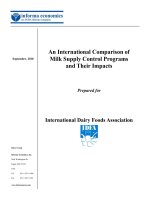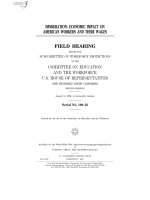Non classical carbene ligands and their coordination chemistry
Bạn đang xem bản rút gọn của tài liệu. Xem và tải ngay bản đầy đủ của tài liệu tại đây (787.15 KB, 78 trang )
BENZIMIDAZOLE-BASED NON-CLASSICAL
CARBENE LIGANDS AND THEIR COORDINATION
CHEMISTRY
ONG HONG LEE
(B.Sc(Hons.), NUS)
A THESIS SUBMITTED
FOR THE DEGREE OF MASTER OF
SCIENCE
DEPARTMENT OF CHEMISTRY
NATIONAL UNIVERSITY OF SINGAPORE
2010
Acknowledgements
First and foremost, I would like to express my deepest gratitude to my Project
Supervisor and mentor, Assistant Professor Huynh Han Vinh, for his kind guidance,
tireless support and limitless patience. I am very fortunate to be under his tutelage, for
in addition to chemistry, I have learnt a great deal about writing, presentation skills,
research ethics and being a better person in general. For educating me above and
beyond the call of duty, I owe him a debt of gratitude.
I would also like to thank my lab mates – Dr. Han Yuan, Dr. Jothibasu and Yuan
Dan for their kind guidance, assistance and useful discussions throughout my time in
the lab and beyond. I would like to extend my thanks to the administrative and
CMMAC staff – Ms. Suriawati, Mdm. Lai, Mdm. Wong, Ms. Tan, Mdm. Hong,
Mdm. Han and Mr. Wong for their diligence and kindness in providing technical
assistance, as well as NUS for the research scholarship.
This project would not be manageable without the support and companionship
from my precious friends – among them: Jun Wei, Zeff, Rong Lun, Justin, Terence
Loh, Terence Lee, Erwin, Mel, Angela, Ivan, Chee Fei, Geck Woon and Tiffany.
Last but not least, I would like to thank my family members – my mother Chong
Hong, always patient; my dad Ah Kiat, always supportive; my sister Hong Nie,
always caring – and my relatives, particularly my aunts – Mdm. Ong Bee Yian, Ms.
Ong Ah Ngo and Ms. Ong Wah Ngoo – who have supported and helped me in
countless ways throughout my academic pursuits.
I am truly privileged to have my life graced with the presence of these benevolent
characters and wish that our journeys together do not ever end.
I
Table of Contents
Summary
IV
Chart 1. Compounds Synthesized in This Work
VI
List of Tables
VIII
List of Figures
IX
List of Schemes
X
XII
List of Abbreviations
1
2
3
4
Introduction
1
1.1
Definition of Carbenes
1
1.2.
Carbenes as Ligands in Metal Complexes
3
1.3.
“Classical” N-Heterocyclic Carbenes
4
1.4.
“Non-classical” N-Heterocyclic Carbenes
8
1.5.
Synthesis of “Non-classical” N-Heterocyclic Carbenes
10
1.6.
Aim and Objective
12
Palladium(II) Complexes bearing R2-2Ph-bim Ligands
15
2.1.
Synthesis and Characterization of Ligand Precursors
15
2.2.
Synthesis and Characterization of Palladium(II) complexes
18
A Palladium(II) Complex bearing a R2-2Me-bim Ligand
27
3.1.
Synthesis and Characterization of Ligand Precursors
27
3.2.
Synthesis and Characterization of Palladium(II) complexes
31
Catalytic Activity of Complex 15
36
4.1.
36
4.2.
Catalytic Activity of 15 in the Buchwald- Hartwig Amination
reaction
Catalytic activity of 15 in the Sonogashira Coupling Reaction
38
II
5
Conclusions
43
6
Experimental
45
Appendix
60
References
62
III
Summary
This thesis deals with the synthesis, characterization and catalytic studies of
organometallic palladium compounds bearing ligands which are potentially remote
N-heterocyclic carbenes. The findings of this research are detailed in three chapters.
Chapter 2 describes the synthesis and characterization of the proligand salts
2-(4-bromophenyl)-1,3-diethylbenzimidazolium
tetrafluoroborate
(Et2-2Ph-bim-
Br)+BF4- (6), 3-benzyl-2-(4-bromophenyl)-1-ethylbenzimidazolium tetrafluoroborate
(EtBn-2Ph-bim-Br)+BF4-
(7),
1,3-dibenzyl-2-(4-bromophenyl)benzimidazolium
tetrafluoroborate (Bn2-2Ph-bim-Br)+BF4- (8) as well as their corresponding
palladium(II) complexes [PdBr(Et2-2Ph-bim)(PPh3)2]+BF4- (9), [PdBr(EtBn-2Phbim)(PPh3)2]+BF4- (10), [Pd Br(Bn2-2Ph-bim)(PPh3)2]+BF4- (11). The proligand salts
were synthesized via alkylation of the two nitrogen atoms in the 2-(4bromophenyl)benzimidazole core. The palladium(II) complexes were synthesized via
oxidative addition to tetrakis(triphenylphosphine)palladium(II). Analysis on the
nature of the ligands in question as carbenes using molecular structural data revealed
that complexes 9-11 may not be remote N-heterocyclic carbene complexes.
Chapter 3 details the synthesis and characterization of the 6-bromo-1,3-dibenzyl2-methylbenzimidazolium tetrafluoroborate proligand (Bn2-2Me-bim-Br)+BF4- (14)
and the corresponding palladium(II) complex [PdBr(Bn2-2Me-bim)(PPh3)2]+BF4(15). 14 was synthesized via alkylation with benzyl bromide on the two nitrogen
atoms in the 6-Bromo-2-methylbenzimidazole core. The palladium(II) complex 15
was synthesized via oxidative addition to tetrakis(triphenylphosphine)palladium(II).
We expect complex 15 to display carbene characteristics based on a comparison of
IV
spectroscopic data with an existing carbene complex of similar nature. However,
spectroscopic analysis is not ample proof to conclude carbene formation and further
studies, such as computational calculations, are required.
In Chapter 4, the catalytic activity of complex 15 was tested in the BuchwaldHartwig amination reaction and the Sonogashira coupling reaction. 15 was active in
both reactions, but gave disappointing yields for the former, while moderately well
for the latter, giving quantitative yields for activated substrates.
Most of the new compounds synthesized in this work have been characterized by
multinuclei NMR, ESI mass spectrometry and X-ray diffraction analyses. These
compounds are depicted in Chart 1.
V
Chart 1. Compounds synthesized in this work
H
N
N
Br
Br
N
N
2
1
N
N
N
Br
N
Br
Br
N
-
3
Br
5
N
N
Br
Br
N
BF4-
6
N
N
BF4-
Br-
4
N
N
Br
N
-
Br
N
BF4-
BF4-
7
PPh3
Pd Br
PPh3
N
N
BF4-
8
PPh3
Pd Br
PPh3
N
N
BF4-
9
10
PPh3
Pd Br
PPh3
11
VI
VII
List of Tables
Table 2.1.
Comparison of 13C{1H} NMR data
22
Table 2.2.
Selected bond lengths (Å) and bond angles (°) for of
25
9·4CH3OH, 10·½C4H10O and 11·3CH3OH
Table 4.1.
Buchwald-Hartwig Amination Reactions Catalyzed by 15
38
Table 4.2.
Sonogashira coupling reactions catalyzed by 15
40
Table 4.3.
Sonogashira coupling reactions catalyzed by 15
42
VIII
List of Figures
Figure 1.1
Frontier orbitals and possible electronic configurations for
2
carbene carbon atoms
Figure 1.2.
Electronic configurations of sp2-hybridized carbenes
2
Figure 1.3.
The first example of a Fischer Carbene
4
Figure 1.4.
The first example of a Schrock Carbene
4
Figure 1.5.
The three types of “classical’ NHC
5
Figure 1.6.
Representative electronic interactions and resonance
7
structures of NHCs
Figure 1.7.
The Second Generation Grubb’s catalyst
8
Figure 1.8.
Some examples of abnormal NHCs
8
Figure 1.9.
Examples of remote carbenes
9
Figure 2.1.
The two major portions of the proposed ligand and its
16
coordination site
Figure 2.2.
Molecular structure of 6
20
Figure 2.3.
Two possible resonance structures of palladium(II)
21
complexes 9-11
Figure 2.4.
The p-orbital overlaps in the carbene complex would
23
constrain the ligand in a rigid, planar geometry.
Figure 2.5.
Molecular structures of 9·4CH3OH, 10·½C4H10O and
24
11·3CH3OH
Figure 3.1.
Molecular structure of 14
30
Figure 3.2.
Molecular structure of 15
33
IX
List of Schemes
Scheme 1.1.
Wanzlick’s attempt at isolating free NHC
5
Scheme 1.2.
Arduengo’s synthesis of the first stable NHC
6
Scheme 1.3.
Canonical valence bond representations of an abnormal
9
NHC
Scheme 1.4.
Abnormal NHC complex synthesis by in-situ deprotonation
10
of azolium salts
Scheme 1.5.
Abnormal NHC complex synthesis via transmetallation
11
Scheme 1.6.
Remote NHC complex synthesized via oxidative addition
11
Scheme 1.7.
Remote NHC complex synthesized via heteroatom
12
alkylation
Scheme 1.8.
Abnormal NHC complex synthesized via cycloaddition to a
12
Fischer carbene complex
Scheme 1.9.
The proposed R2-2Ph-bim ligand system
13
Scheme 1.10.
The proposed R2-2Me-bim ligand system
14
Scheme 2.1.
Synthesis of the ligand precursor salts
16
Scheme 2.2.
Mechanism for the formation of 1
17
Scheme 2.3.
Synthesis of palladium(II) complexes by oxidative addition
20
Scheme 3.1.
The designed ligand system and possible resonance
28
structures of the resulting complex
Scheme 3.2.
Synthesis of the ligand precursor salt
29
Scheme 3.3.
Synthesis of the palladium(II) complex by oxidative
32
addition
X
Scheme 3.4.
Attempted synthesis of procarbene complexes 16a/b
34
Scheme 3.5.
Synthesis of complex 16c
35
Scheme 4.1.
The Buchwald-Hartwig amination reaction
37
Scheme 4.2.
The Sonogashira coupling reaction
39
Scheme 4.3.
Synthesis of compound 16 via Sonogashira Coupling
41
XI
List of Abbreviations
Anal. Calc.
Analysis calculated
Ar
Aryl
br
Broad
Bn
Benzyl
ca
About (Latin circa)
d
Doublet (NMR) / day
dd
Doublet of doublet (NMR)
DME
Dimethoxyethane
DMF
Dimethylformamide
DMSO
Dimethylsulfoxide
δ
NMR chemical shift
e.g.
For example (Latin exempli gratia)
Equiv.
Equivalent(s)
ESI
Electrospray ionization
Et
Ethyl
et al.
And others (Latin et alii)
etc.
And so on (Latin et cetera)
h
Hour
I
Inductive effect
J
Coupling constant
m
Multiplet (NMR)
M
Mesomeric effect
XII
min
Minute
MS
Mass spectrometry
m/z
Mass to charge ratio
NMR
Nuclear Magnetic Resonance
RT
Room temperature
s
Singlet (NMR)
t
Triplet (NMR)
THF
Tetrahydrofuran
XIII
Chapter 1. Introduction
1.1 Definition of Carbenes
Carbenes are neutral compounds containing a divalent carbon atom with six
valence electrons. A carbene can be described as an organic molecule with the
general formula RR’C:, in which the carbene carbon atom contains a pair of
nonbonding electrons and is covalently bonded to two other atoms.
Depending on the degree of hybridization, the geometry at the carbene carbon
atom can either be bent or linear. When a carbene centre is sp-hybridized with two
nonbonding energetically degenerate p-orbitals( the px and py orbitals), the linear
geometry is adopted. On the other hand, when the carbene carbon atom is sp2hybridized, the bent geometry is adopted. Upon transition from the sp- to sp2hybridization, the energy of pπ remains relatively unchanged while the newly formed
sp2-hybrid orbital, noted as σ, is energetically stabilized as it acquires partial s
character (Figure 1.1). Most carbenes contain a sp2- hybridized carbene centre, hence
linear carbenes are rarely observed.
Four conceivable electronic configurations for the carbene centre are available: a
triplet ground state (3B1) in which the two nonbonding electrons occupy the two
different orbitals with parallel spins (σ1pπ1), two different singlet ground states (1A1
state) in which two nonbonding electrons are paired with antiparrallel spins in the
same σ or p orbital (σ2pπ0 and σ0pπ2) and an excited singlet state (1B1) with
antiparallel occupation of the σ and p orbitals (σ1pπ1).1
1
py
linear
px
p
3
B1( p
p
bent
1
A1( p
Figure 1.1 Frontier orbitals and possible electronic configurations for carbene carbon
atoms1a
Figure 1.2. Electronic configurations of sp2-hybridized carbenes.
The reactivity and properties of carbenes are fundamentally determined by their
ground-state spin multiplicity.2 Singlet carbenes contain a filled and an empty orbital
and thus exhibit ambiphilic character. Triplet carbenes are considered diradicals as
they have two orbitals with unpaired electrons. The multiplicity of the ground state is
related to the energy gap between the σ and pπ orbitals. A Large energy difference in
excess of 2 eV would stabilize a singlet ground state, leading to a singlet carbene
while a smaller energy gap of less than 1.5 eV would lead to a triplet ground state.
Steric and electronic effects brought about by the substituents at the carbene carbon
2
atom are known to influence the relative energy of the two orbitals and in turn
influence the multiplicity of the ground state.3 For example, electron withdrawing
substituents, which inductively stabilize the σ orbital by enriching its s character
while leaving the pπ orbital relatively unchanged, increases the energy gap between
the σ and pπ orbitals and thus favour the singlet state.
On the other hand, electron donating groups decrease the energy gap between the
two orbitals and stabilize the triplet state. Apart from inductive effects, mesomeric
effects of the substituents also play a significant role. When the carbene carbon is
attached to π-electron withdrawing group such as COR, CN, CF3 BR2 or SiR3, the
triplet state is favoured. Likewise, if the carbene atom is attached to π-electron
donating groups like N, O, P, S or halogens, the energy of the pπ orbital is increased,
thus favouring the singlet state.
1.2 Carbenes as Ligands in Metal complexes
The first example of a metal complex incorporating a carbene ligand was reported
by Fischer in 1964.4 A double bond is drawn from the carbon donor atom to the metal
centre due to the two types of interaction between the metal and the ligand: σdonation from the lone pair of the carbon to an empty metal d-orbital and π-back
bonding of a filled orbital on the metal to the empty p-orbital of the carbon In this
class of carbene complexes, the substituents on the carbon donor are π-donating, such
as O or N. The metal centres usually consist of middle to late transition metals in a
3
low oxidation states. This class of complexes also contains π-acceptor co-ligands such
as CO. In this case, the reactivity of the carbene carbon atom is electrophillic.
Figure 1.3. The first example of a Fischer Carbene
In a later study, Schrock reported a second class of metal carbene complexes – the
Schrock carbenes.5 The carbon donor atoms in this type of complexes do not contain
π-donating substituents, while the metal centres are early transition metals in high
oxidation states. Schrock carbenes are nucleophillic, and are in the singlet state.
Ta
Figure 1.4. The first example of a Schrock Carbene
1.3 “Classical” N-Heterocyclic Carbenes
A special class of Fischer carbene that has caught much attention lately is the Nheterocyclic carbene (NHC). In NHCs, the carbene carbon atom is incorporated into a
heterocyclic ring. The classical representation of this type of ligands describes the
carbon donor atom as being flanked by two nitrogen atoms in a five-membered
heterocyclic ring. The heterocyclic ring can be saturated (imidazolidin-2-ylidenes, A),
4
unsaturated (imidazolin-2-ylidenes, B), or benzannulated (benzimidazolin-2-ylidenes,
C).
A: Imidazolidin-2-ylidene
B: Imidazolin-2-ylidene
C: Benzimidazolin-2-ylidene
R
N
R
N
N
R
N
R
Figure 1.5. The three types of “classical” NHC.
NHCs were initially studied by Wanzlick in the year 1962, when he reported the
elimination of chloroform from an imidazoline derivative (Scheme 1.1, A).
Unfortunately, the proposed imidazolin-2-ylidene (Scheme 1.1, B) could not be
isolated and characterized as it dimerized into the corresponding enetetramine
(Scheme 1.1, C). 6 Wanzlick further substantiates the formation of NHCs by trapping
them as transition metal complexes7.
Scheme 1.1. Wanzlick’s attempt at isolating free NHC.
However, NHC chemistry remained relatively unexplored until the first stable free
NHC was successfully isolated and spectroscopically characterized by Arduengo et.
5
al in 1991.8 Arduengo and co-workers obtained the first stable free NHC via the
deprotonation of the corresponding imidazolium salt using sodium hydride as a base
in the presence of a catalytic amount of DMSO in THF (Scheme 1.2). The stability of
this type of bent singlet carbenes can be accounted by two factors: the mesomeric (M)
and inductive (I) effects, collectively known as the “push-pull effect”. The +M effect
‘pushes’ the lone pair electrons from the N atoms into the vacant pπ orbital of the
carbene carbon atom, while the –I effect of the σ-electron withdrawing N atoms
‘pulls’ electrons from the carbene center. These two effects bring about an increment
in the energy gap between the σ and pπ orbitals, thus stabilizing the singlet carbene.
Figure 1.6 shows a pictorial representation of the electronic interactions and their
resonance structures.
Scheme 1.2. Arduengo’s synthesis of the first stable NHC
Arduengo’s discovery sparked interest in NHC chemistry, and as a result rapid
development in the syntheses and applications of NHCs followed. In particular, NHC
metal complexes found extensive application in the field of catalysis. Studies on the
properties of NHCs revealed that NHCs are strong σ-donors and relatively poor π-
6
acceptors, similar to trialkylphosphines,9 which are widely used as ligands in metal
catalysts. In fact, studies showed that NHCs are even more Lewis basic than electron
rich phosphines and can potentially improve the stability and performance of well
established catalytically active metal-phosphine complexes.
X
X
X
X
X
X
X
X
X
X
X = NR
Figure 1.6. Representative electronic interactions and resonance structures of NHCs.1
In light of this, many successful examples of the application of NHC complexes in
organic transformations have been developed. Among them are: a) olefin metathesis
catalyzed by ruthenium NHC complexes; b) C-C and C-N cross coupling reactions
catalyzed by palladium NHC complexes; c) hydrosilylation of alkenes and alkynes
catalyzed by Pt(0) NHC complexes; d) oligomerization and polymerization catalyzed
by nickel NHC complexes; e) hydrogenation of alkenes and alkynes catalyzed by
iridium or rhodium NHC complexes. The most notable of these studies is perhaps the
development of the second generation Grubb’s catalyst, (Figure 1.7) which
contributed to him being awarded the Nobel Prize in Chemistry in 2005. Substitution
of a tricyclohexyl phosphine ligand in the first generation Grubb’s catalyst with a
7
NHC ligand led to a significant improvement in the stability of the catalyst for olefin
metathesis reactions.
N
Cl
Cl
N
Ru
Ph
PCy3
Figure 1.7. The Second generation Grubb’s catalyst
1.4 “Non-Classical” N-Heterocyclic Carbenes
While most research on the topic of NHCs has been centered on the Arduengotype carbenes, where the carbene carbon atom is stabilized by two adjacent nitrogen
atoms, there has been increasing interest in extending the NHC concept in different
directions. In light of this, two new concepts of NHCs with less heteroatom
stabilization have emerged in the recent years: the abnormal NHC concept and the
remote NHC (rNHC) concept.
Abnormal NHCs refer to NHCs for which a canonical valence bond representation
requires the introduction of additional formal charges on some nuclei (Scheme 1.3).10
In most cases, these carbenes are only adjacent to one heteroatom (Figure 1.8).
Figure 1.8. Some examples of abnormal NHCs.
8
Scheme 1.3. Canonical valence bond representations of an abnormal NHC.
On the other hand, remote NHCs refer to carbenes which are stabilized by remote
heteroatoms. This class of carbenes differ from the classical NHCs since they contain
no heteroatom at the position α to the carbene centre. In this case, the heteroatom can
be located within the same ring as the carbenoid carbon (Figure 1.9, A-C) or in an
adjacent ring (Figure 1.9, D and E).11
N
A
B
N
C
D
N
E
Figure 1.9. Examples of remote carbenes.
Experimental and theoretical studies have shown that carbene ligands with less
heteroatomic stabilization are not only more donating than classical NHCs, but also
show better activity in certain catalytic reactions.10
9
1.5 Synthesis of “Non-Classical” N-Heterocyclic Carbenes
With the rising interests in “non-classical” NHC chemistry, a number of known
methods have been developed for the synthesis of remote and abnormal NHC
complexes. An overview of a few known methods is outlined below:
a) In situ deprotonation of azolium salts. This method is more commonly used as
a route to abnormal NHC complexes rather than remote carbene complexes. It
involves the deprotonation of an acidic procarbene proton of an azolium salt
either by suitable external bases or metal complexes with a basic ligand. For
instance, the diimidazolium salt (Scheme 1.4) is deprotonated by the basic acetate
ligands from Pd(OAc)2 to form the corresponding abnormal NHC complex.12
I- N
N
N
Pd(OAc)2
N
DMSO, 120 C
N
I
Pd
N
I- N
I
N
Scheme 1.4. Abnormal NHC complex synthesis by in-situ deprotonation of azolium
salts.13
b) Transmetallation of silver carbene complex. The transmetallation protocol,
initially developed by Lin and co-workers for the preparation of classical NHC
complexes,13 can also be extended to the synthesis of abnormal NHC complexes.
This method makes use of Ag2O as a metal precursor to deprotonate the azolium
salts to generate Ag-NHC complexes. Due to the labile Ag-Ccarbene bond, the Ag10
NHC complexes can act as transfer reagents to other metals such as Pd, Rh, Au
and Ir.
Scheme 1.5. Abnormal NHC complex synthesis via transmetallation.14
c) Oxidative addition. Initially reported by Stone in 1974,15 this method involves
the oxidative addition of a C-X bond to a low oxidation-state metal precursor such
as [Ni(COD)2] or [Pd(PPh3)4]. Both abnormal and remote NHC complexes have
been synthesized in this manner.16,11 This method is the main protocol used to
synthesize the metal complexes presented in this dissertation.
Scheme 1.6. Remote NHC complex synthesized via oxidative addition.16d
d) Heteroatom alkylation. In this method, a metal complex with a heterocyclic
ligand can be alkylated at the heteroatom to generate a remote or abnormal
carbene complex. For example, the aryl complex below is alkylated with a methyl
substituent at the N atom to give rise to the corresponding rNHC complex.17
11









